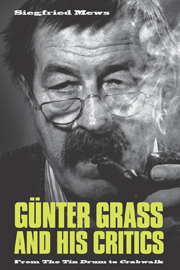Book contents
- Frontmatter
- Contents
- List of Abbreviations
- Introduction
- Part 1 Danzig, Center of the Universe
- 1 Die Blechtrommel / The Tin Drum
- 2 Katz und Maus / Cat and Mouse
- 3 Hundejahre / Dog Years
- 4 Danziger Trilogie / The Danzig Trilogy
- Part 2 From Danzig to the Global Stage: Grass's Fiction of the 1970s and 1980s
- Part 3 After Reunification: Old Problems and New Beginnings
- Epilogue
- Works Cited
- Index
3 - Hundejahre / Dog Years
from Part 1 - Danzig, Center of the Universe
Published online by Cambridge University Press: 05 February 2013
- Frontmatter
- Contents
- List of Abbreviations
- Introduction
- Part 1 Danzig, Center of the Universe
- 1 Die Blechtrommel / The Tin Drum
- 2 Katz und Maus / Cat and Mouse
- 3 Hundejahre / Dog Years
- 4 Danziger Trilogie / The Danzig Trilogy
- Part 2 From Danzig to the Global Stage: Grass's Fiction of the 1970s and 1980s
- Part 3 After Reunification: Old Problems and New Beginnings
- Epilogue
- Works Cited
- Index
Summary
A Literary Sensation?
THE PUBLICATION OF Grass's second novel, Hundejahre, which appeared in September 1963, was preceded by advance publicity: prior to its availability in bookstores excerpts were published, and Grass read from his manuscript in a TV broadcast — a distinctly uncommon practice at the time. If the novel did not, perhaps, become quite the “literary sensation” that at least one reviewer predicted (Ungureit 1963), the resonance it achieved in terms of both critical acclaim and sales figures — three hundred thousand copies were sold within three months, owing in part to the skillful publicity campaign on the part of Grass's publisher, Luchterhand — was quite remarkable, particularly in view of the work's complexity and considerable length of more than seven hundred pages. The influential journal Der Spiegel (4 September 1963) featured a substantial cover story — the first of several others that were to follow in the course of the decades — by an anonymous contributor about the then thirty-five-yearold “bestseller author” Grass. The story combines biography and literary criticism with an emphasis on Grass's Danzig roots; in a pattern adopted by most critics, Der Spiegel engages in a comparison of Die Blechtrommel and Hundejahre, but unlike other reviews, the magazine deems Grass's second novel the equal of his first in terms of its abundant length, attention to detail, exuberantly fantastic elements, and drastic recklessness (65). Apart from acknowledging the literary merits of the work, the story also signals that Grass had reached what was then the zenith of his fame; the author's eminence was to continue to grow both independently of and in conjunction with his literary activities (see H. Zimmermann 2006, 117–22).
- Type
- Chapter
- Information
- Günter Grass and his CriticsFrom 'The Tin Drum' to 'Crabwalk', pp. 77 - 91Publisher: Boydell & BrewerPrint publication year: 2008



